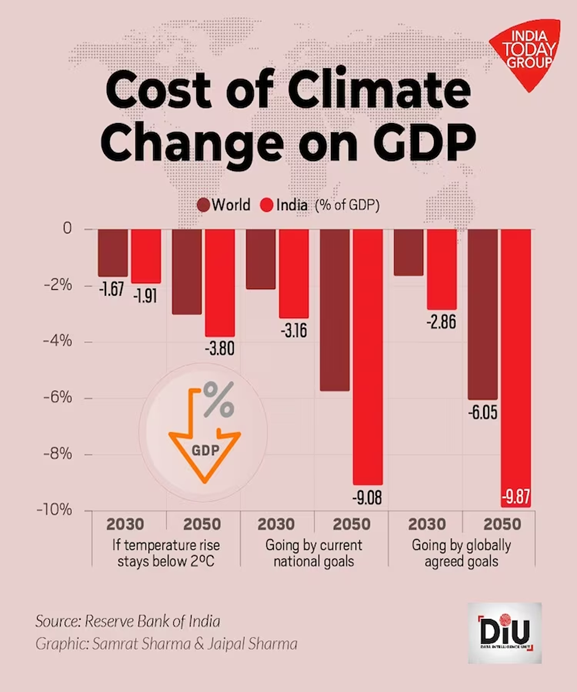GO FOR COOPERATIVE CLIMATE FEDERALISM
Relevance:
- GS 2 – Parliament and State legislatures—structure, functioning, conduct of business, powers & privileges and issues arising out of these.
- GS 3 – Conservation, environmental pollution and degradation, environmental impact assessment.
Why in the news?
- States’ support is essential for unlocking the market’s full potential and addressing climate change
- Budget allocations often heavily favor revenue expenditure, comprising 95% of the total, while capital expenditure remains relatively neglected.
Government Focus on Climate Change
- In 2014, the Government of India integrated Climate Change into the Ministry of Environment and Forest, emphasizing its significance.
- This move reflects the government’s dedicated focus on addressing climate change issues.
- According to the European Commission Report, India’s share of global CO2 emissions increased from 4.32% in 1990 to 33% in 2022.
- By 2022, major contributors to CO2 emissions were China (29.2%), the US (11.2%), EU27 (6.7%), Russia (4.8%), and Brazil (2.4%), with the rest of the world accounting for 38.4%.
- Despite constituting 17% of the global population, India’s contribution remains lower than China’s.
Government Spending on Climate Change
- India allocates approximately 5% of its GDP towards climate change initiatives.
- In contrast, European governments allocated between 0.2% to 1.5% of their general government expenditure on environmental protection in 2021.
- Climate budgeting has emerged as a necessity for governments worldwide.
- Except for Odisha, none of India’s states have made significant strides in climate budgeting.
- Cooperative climate federalism is essential for shared responsibility in mitigating climate change.
Election Campaign Promises
- If between two Candidates A and B, Candidate A pledges a 10% reduction in tax rates and Candidate B vows to lower greenhouse gas emissions and limit temperature rise to no more than 1.5°C above pre-industrial levels, aligning with the Paris Climate Agreement.
- In the current context, Likelihood of Election Outcome is Candidate A may have an advantage due to the perceived prioritization of economic concerns over environmental ones.
- Awareness and understanding of the importance of climate change in everyday consumption habits may still be lacking among the general population.
Understanding Climate Change and Mitigation
- Weitzman (2014) introduced the concept of ‘tail risk’ highlighting the potential for significant loss from infrequent and gradual events, such as climate change.
- Adopting eco-friendly strategies and resilient policies can help delay or mitigate the impact of these tail risks.
- To combat climate change effectively, shared global action is crucial to prevent the tragedy of the commons.
- Many sovereign nations are transitioning to renewable energy sources from conventional fossil fuels like coal and petroleum, albeit at a slow pace.
- India’s approach to combating climate change involves a multifaceted strategy, including policy initiatives, international commitments, and the development of renewable energy sources.
- The Indian government has set an ambitious target of achieving 50% cumulative electric power installed capacity from non-fossil fuel-based energy resources by 2030.
Transition to Renewable Energy
- According to the Ministry of Power, fossil fuel-based power has decreased from 69% to 57% in the past decade.
- India’s current power generation capacity stands at 424 GW, with approximately 180 GW coming from non-fossil fuel sources as of November 2023.
- The Central Electricity Authority has set an ambitious target to add 472 GW of installed capacity between 2022-2032, with solar (279 GW) and wind (94 GW) contributing nearly 80%.
- This aligns with India’s commitment to achieve 500 GW of non-fossil generation capacity by 2030, requiring heavy investments estimated at Rs 32 lakh crore.
Budget Allocation for Environment and Climate Change
- In 2023-24, the Ministry of Environment, Forests, and Climate Change received an allocation of Rs 3,079 crore, a 24% increase from the revised estimates of 2022-23.
- However, the budget allocation is heavily skewed towards revenue expenditure, with 95% dedicated to functional aspects such as administrative expenses, salaries, maintenance, and operational funding for environmental programs.
Investment Challenges and Funding Sources
- The Ministry of Finance estimated the overall expenditure required for India to adapt to climate change at around Rs 85 lakh crore at base year (2012) prices.
- Heavy investments, both public and private, are needed in the renewable energy sector, with domestic sources contributing around 50% of the required funds.
- The banking sector has shown hesitancy in funding renewable energy initiatives, highlighting the need for seamless integration between states and market potential.
Global Financial Support and Trust Deficit
- At the 15th Conference of the Parties in Copenhagen in 2009 (COP 15), developed countries pledged $100 billion per year till 2020 to assist developing countries in tackling climate change.
- However, the actual disbursement of promised funds was delayed and often lower than pledged amounts, leading to a trust deficit between developed and developing countries.
Interim Budget Highlights
- In the interim Budget for 2024-25, the terms ‘climate challenges’ and ‘climate resilience’ were mentioned, indicating a recognition of environmental concerns.
- Limited focus on climate finance and budgeting was observed, likely due to the interim nature of the Budget.
- Key Schemes:
- Rooftop solarisation initiative aims to empower one crore households, providing up to 300 units of free electricity monthly.
- Anticipated impacts include significant savings for beneficiary households (up to Rs 18,000 annually) and the creation of an additional income source through surplus energy sales to distribution agencies.
- This initiative is expected to drive the electric vehicle (EV) charging ecosystem by boosting infrastructure for charging stations, aligning with the goals of the Faster Adoption and Manufacturing of Hybrid and Electric Vehicles (FAME) scheme.
- Alignment with Pradhan Mantri Suryodaya Yojana:
- The rooftop solarisation scheme aligns with the Pradhan Mantri Suryodaya Yojana, aiming to promote solar energy adoption.
- By December 2023, approximately 8 lakh households had embraced solar panels, resulting in a cumulative installed capacity of around 11 GW.
- Political Implications:
- The government’s confidence in the outcome of the upcoming general elections may have influenced the Budget’s restrained approach.
- Massive push for rooftop solar panel installations before the Lok Sabha elections may serve as a visual demonstration of progress, albeit potentially lacking substantive impact beyond symbolic representation.
Source: https://telanganatoday.com/opinion-go-for-cooperative-climate-federalism
Mains question
Discuss the efficacy of India’s interim Budget 2024-25 in addressing climate challenges and the broader implications for sustainable energy practices. (250 words)




